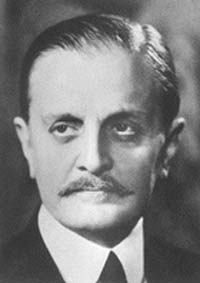- Carlos Saavedra Lamas
Infobox Person
name = Carlos Saavedra Lamas

image_size = 200px
caption =
dead = yes
birth_date = birth date|1878|11|1|mf=y
birth_place =Buenos Aires ,Argentina
death_date = death date and age|1959|5|5|1878|11|1|mf=y
death_place =Buenos Aires ,Argentina
occupation = Politician, diplomat
Awards/Honours=Nobel Prize , 1936Carlos Saavedra Lamas (
November 1 ,1878 –May 5 ,1959 ) was an Argentinian academic andpolitician who received theNobel Peace Prize in 1936. He was the firstLatin American to receive such an award.Saavedra, born in
Buenos Aires into the Argentinian aristocracy, was an outstanding student who received his doctorate in laws from theUniversity of Buenos Aires , and then began a career as a teacher of law andsociology at theUniversidad Nacional de La Plata , eventually rising to the position of professor at Buenos Aires.As an academic, some of his major published works concentrated on
labor law , placing an emphasis on the need for a universally recognized doctrine on the treatment of labor. Some of his most important works in this field are "Centro de legislacíon social y del trabajo" (1927), "Traités internationaux de type social" (1924), and the National Code of Labour Law ("Código nacional del trabajo", 1933). He was involved in the early stages of theInternational Labour Organization (ILO), and much of his work eventually ended up being the basis of Argentina's own labor laws.His political career began in 1906 through a succession of steadily more important roles, including two terms in the Argentinian parliament beginning in 1908, where his interests were mainly in
foreign affairs . In 1915, he becameMinister for Justice and Education .The achievement for which he received the Nobel Prize was as Argentina's foreign minister, which he was from 1932 to 1938 (during the presidency of Gral.
Agustín P. Justo ), mediating a treaty that effectively ended theChaco War betweenParaguay andBolivia and instigating several multilateral nonaggression treaties between a number of South American and European countries. The most notable of these was the innovativeSouth American Anti-War Pact , which, in case of a war between two or more signatories, bound all remaining countries to create special committees for the ceasing of the hostilities and to take diplomatic or economic actions against both offending parties until they agreed to stop their hostilities. This treaty was ratified by most Latin American nations, and later was well-received in a presentation in the League of Nations, which prompted eleven other American and European nations to sign it.In 1936 he was elected President of the Assembly of the
League of Nations .Saavedra married the daughter of a former Argentinian president.
From 1941 to 1943 he was president of the University of Buenos Aires, and then professor until 1946.
Carlos Saavedra is buried in
La Recoleta Cemetery in Buenos Aires.References
* [http://www.nobel.se/peace/laureates/1936/index.html Nobel Committee information on Lamas]
Wikimedia Foundation. 2010.
